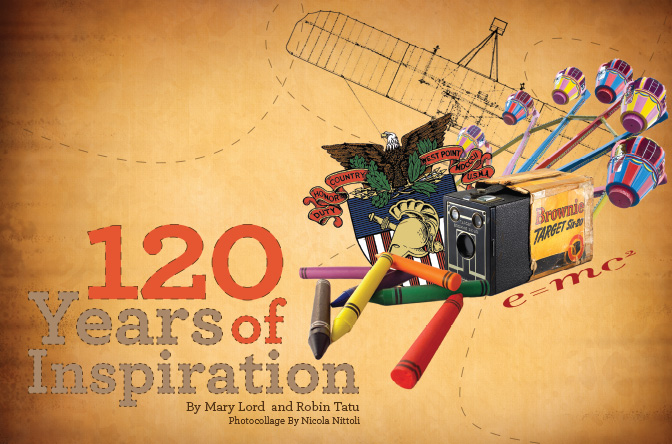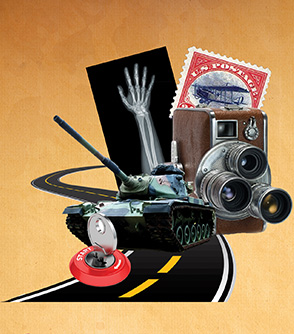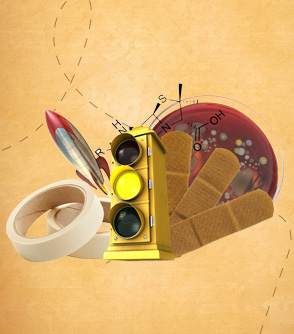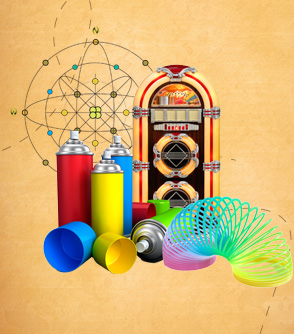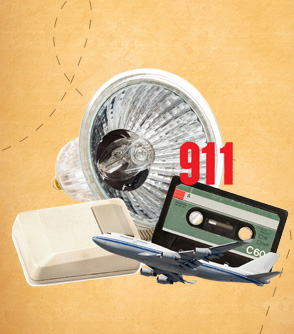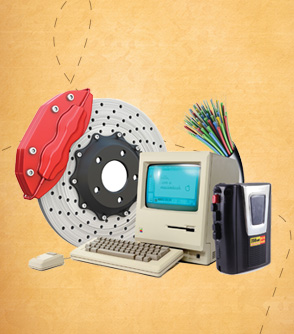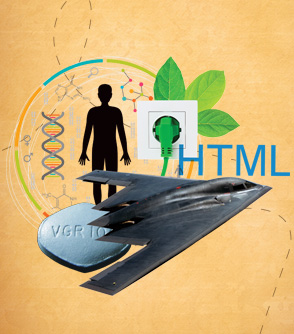Summer 2013 – Cover Story
ASEE’s founding in 1893 coincided with an era of unprecedented technological progress driven by engineering innovation, entrepreneurship, and invention. Preceding decades saw engineering shift from apprenticeships to classroom instruction, with the earliest curricula established at West Point (1802) and Rensselaer Polytechnic Institute (1825). The Civil War and the 1862 Morrill Land Grant Act fueled a dramatic growth in programs, particularly at state universities; by 1880, there were 85 U.S. engineering schools—up from just 17 a decade earlier. Soon, colleges were producing the bulk of America’s engineers.
Few of the founders gathered at the Chicago World’s Fair likely imagined how profoundly technology would transform society or engineering education. The 20th century brought motorcars – along with traffic signals, roads, oil refining, gas stations, and route-numbering systems. Radio, television, and motion pictures made their debut, spawning an unrivaled entertainment industry. Air-conditioning, refrigeration, power plants, and distribution grids enabled 24/7 commerce. Skyscrapers rose, huge dams irrigated the desert, and elegant spans connected once distant communities. So did the telephone and, later, the Internet.
Meanwhile, aerospace opened the friendly skies and landed humans on the moon. CT scans and artificial heart valves extended life spans. War—and federal research efforts—spurred many of the century’s biggest technical feats, while peace generated more playful pursuits. Throughout the decades, as the following time line attests, ASEE kept pace, fostering deep, sometimes tough conversations to ensure America’s continued pre-eminence in engineering innovation.
1900: THE WRIGHT STUFF
- Revolutionary changes arrive in appliances, communications, and mobility. Brothers Orville and Wilbur Wright manage to control a flying machine, air conditioners cool offices, vacuum cleaners mechanize housework, and America’s love affair with the car takes off with the first Model T.
- The first professional agricultural engineering curriculum established at Iowa State; University of Cincinnati launches first co-op program (1906), followed by Northeastern (1909).
- The Society for the Promotion of Engineering Education (SPEE), now ASEE, issues its first committee report on admissions policies; membership reaches 503 in 1907.
1910s: THE “GREAT WAR” SPURS INNOVATIONS
- The fledgling era of flight brings air mail, advances in avionics, and aerial warfare. Automobile mass production spurs development of asphalt, paved roads, and oil-extraction techniques. Concrete, stainless steel, flash-frozen food, pop-up toasters, water chlorination, and the first transcontinental phone call debut.
- Engineering disciplines and specialization expand. Most engineers are now university trained, up from 5 percent in 1871.
- SPEE produces the first major study of U.S. engineering education, the Mann report, which calls for a common curriculum and attention to ethics in engineering. Membership hits 1,500.
-
1920s: ROARING ADVANCE
- Insulin and penicillin save lives, even as the first tommy guns claim them. Innovations range from the iron lung and Band-Aids to power steering, leaded gas, rockets, and spiral notebooks.
- States begin licensing engineering schools. Engineering education moves from technical training toward science, humanities, and societal relationships.
- SPEE’s Wickenden report advocates humanities study, while its first faculty summer schools discuss pipeline, standards, and accreditation issues. The Journal of Engineering Education launches.
1930s: GLOBAL DEPRESSION, BIG DIGS & NEW MATERIALS
- Iconic public works projects like Hoover Dam and the Golden Gate Bridge bracket an era that gave rise to Scotch tape, Polaroid cameras, nylon, fiberglass, canned beer, FM radio, and helicopters.
- European engineering educators bring mathematical analyses to the study of fluid dynamics, materials, and structural mechanics. Purdue starts the first common first-year engineering curriculum in 1934; Amelia Earhart is a visiting faculty member in 1935.
- SPEE admits its first institutional members and cofounds the first accrediting body, the Engineers Council for Professional Development (ECPD), in 1932; Stevens Institute and Columbia University are first to sign up. By 1937, 374 of 626 curricula are approved.
1940s: WARTIME
SCIENTIFIC ADVANCES
- The war effort spurs breakthroughs from rockets to radar, fighter jets, electric-digital computing, and atomic bombs.
- Rensselaer Polytechnic Institute begins admitting women. Postwar federal funding shifts engineering programs toward research, and the G.I. bill ramps up enrollment in higher education.
- SPEE’s 1940 Hammond report emphasizes science fundamentals over vocational training. SPEE helps create the Engineering College Research Association (1942), moves headquarters to Northwestern University (1943), and changes its name to ASEE (1946).
1950s: COLD WAR, HOT PRODUCTS
- The nuclear arms race commences, as does atomic power production. Color TV, transistor radios, long-distance telephone service, interstate highways, and Barbie dolls take off. So, too, does the Pill.
- The Society of Women Engineers and the National Science Foundation are established (1950); the University of Pennsylvania awards the nation’s first doctorate in bioengineering (1953). Defense efforts draw researchers further from industry practice.
- As the established voice for engineering education, ASEE sends teams to the Soviet Union and India, revises its teaching manual, and administers government programs and education surveys. In 1954, headquarters moves to the University of Illinois and becomes self-supporting. Membership hits 8,000.
1960s: THE SPACE AGE
- Tuned in (to TV) and turned on (to social problems), Americans believe engineers will propel man to the moon – and beyond. Developments include Valium, Kevlar, carbon fiber, the Boeing 747, Star Trek, the computer mouse, and the first handheld calculator.
- The National Academy of Engineering is incorporated (1964). The next year, NAE elects its first woman: industrial engineer Lillian Gilbreth. Mississippi State creates the first undergraduate engineering program (1967). Purdue launches the nation’s first women-in-engineering program (1969).
- ASEE moves to Washington, D.C., in 1964 to be “the voice of engineering education,” working with government organizations and encouraging funding for minority populations. The push for a uniform curriculum and master’s degree stirs controversy, prompting engineering technology groups to challenge ASEE’s leadership in engineering education. Membership tops 12,000 in 1966.
1970s: DIGITAL FRONTIERS
- The era of garage start-ups spawns ever faster computers, PONG and videogames, word processing, email, spreadsheets, Star Wars, Post-it notes, a nascent Internet, and cellphones. CT and MRI scans fight America’s war on cancer while soaring gas prices drive demand for fuel-efficient cars. Earth Day and the first test-tube baby arrive.
- The Society of Hispanic Professional Engineers (1974) starts up in Los Angeles; the National Society of Black Engineers is founded at Purdue (1975); the American Indian Science and Engineering Society begins (1977).
- ASEE focuses increasingly on best teaching practice, not research, and on the expanded involvement of its members, divisions, and councils. Engineering technology and studies of under-represented minorities gain attention. Annals of Engineering Education launches in 1975.
1980s: PCs & MTV
- The CD-ROM, IBM PC, Macintosh, Internet, domain names, and other disruptive technologies automate offices, schools, and homes, connecting people in new ways. MTV and antilock brakes debut along with controlled drug-delivery technology, the scanning tunneling microscope, Prozac, and the “morning-after pill”: RU-486.
- In 1980, ECPD is renamed the Accreditation Board for Engineering and Technology (ABET). Eleanor Baum becomes the first woman engineering dean in 1984 at Pratt Institute.
- The ASEE Engineering Deans Council establishes a federal liaison office. Engineering technology education and engineering education research come to the fore. Membership peaks at 13,000 in 1980, declining to 9,500 by decade’s end.
1990s: DOT-COM REVOLUTION
- The World Wide Web takes off with Netscape, Google, URLs, and html. The Human Genome Project launches the quest to map man’s every chromosome, the Hubble Space Telescope, international space station and B-2 bomber deploy. Viagra hits the market.
- In 1997, ABET adopts Engineering Criteria 2000, emphasizing innovation and engineering design; capstone projects and hands-on labs become standard.
- Prism launches in 1991. ASEE moves into its current headquarters in 1993, hooks up to the Internet, and elects its first female president, Eleanor Baum.
2000 & BEYOND: LIVING SOCIAL
- Google, spam, and friend become verbs. GPS, ATMs, camera phones, and RFID become ubiquitous. Space is commercialized, nanotechnology infuses products, and Apple becomes the world’s biggest purveyor and player of digital music.
- Utah State launches the nation’s first stand-alone engineering and technology education program in 2003. Purdue establishes the School of Engineering Education in 2004 and Virginia Tech sets up a department of engineering education. Stanford and MIT pioneer free massive open online courses (MOOCs).
- ASEE doubles in size, expands fellowships, and helps establish the International Federation of Engineering Education Societies (IFEES) and Global Engineering Deans Council (GEDC). In 2003 Engineering, Go For It (eGFI), ASEE’s magazine and website for K-12 students, debuts. In 2012, engineering deans attend the White House launch of an initiative to produce 10,000 more U.S. engineering graduates annually; ASEE begins a project to collect retention data and helps develop new K-12 science standards that include engineering design.
Category: ASEE TODAY
